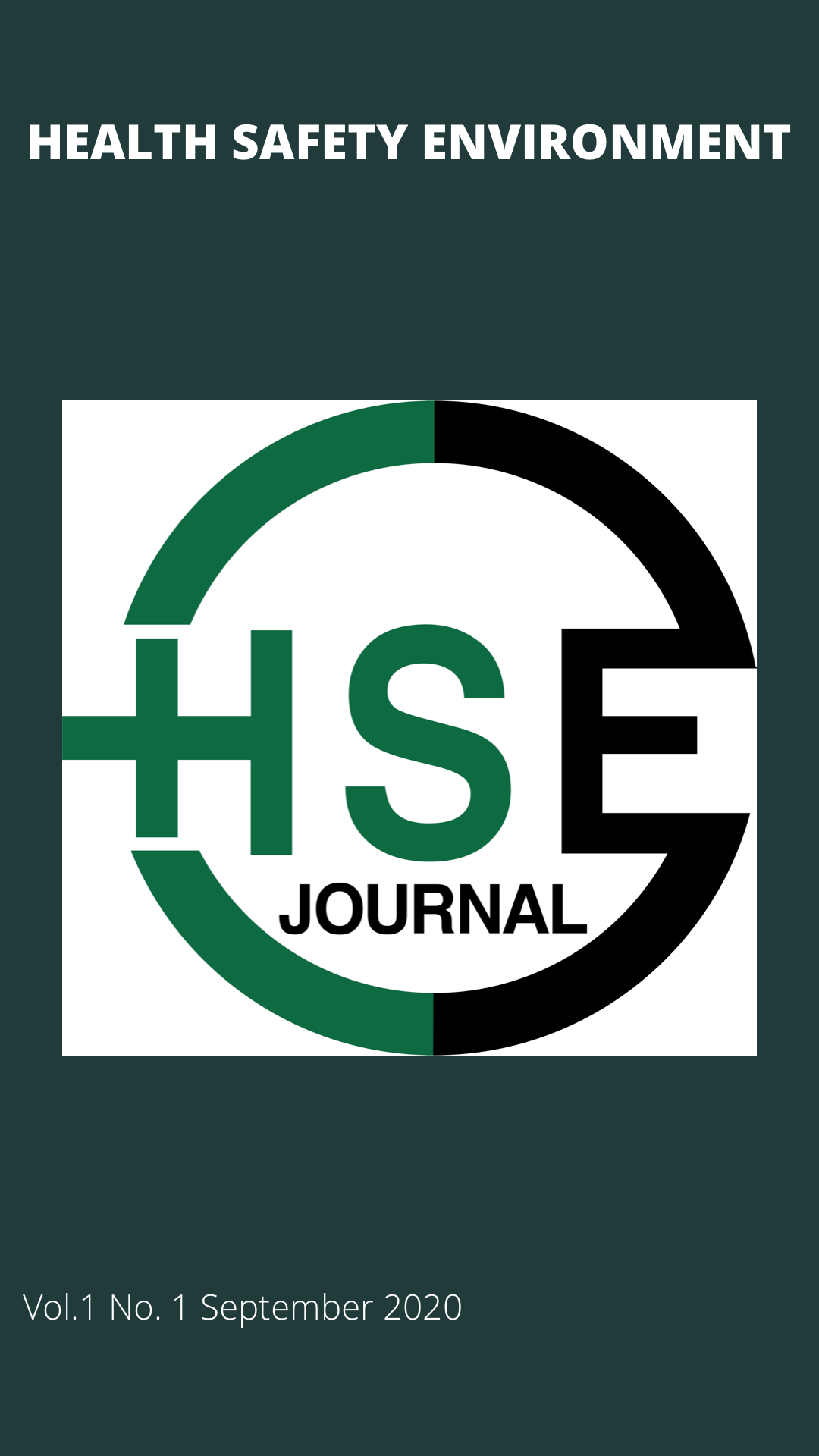Risk Management of Occupational Health and Safety on Mechanical, Formwork, and Reinforcing Iron Work Process at X Building Project 2020
Abstract
Risk management is a work process included recognizing, identifying, and assessing risk hazards. This program is one of the components that illustrates the fundamental of occupational health and safety in a company. The purpose was to identify the category of each risks and find the most accurate way to control. This research is semi-quantitative with descriptive design, using interview guidelines, observation checklist, and self-assessing risk based on AS/NZS 4360:2004. Result showed highest risks for mechanical work are risk of workers could had an electric shock while repairing electrical tools; formwork are risk of workers can fall while doing a job on column (over 2 meters) and risk of workers can inhale wood dust while working on wood’s fabrication; lastly, reinforcing iron work are risk of workers can be breathing on particles of irons or concrete dust while doing an iron fabrication. Corona virus was also highest risk for workers. Therefore, researcher gave recommendation by: (1) Installation of barrier around electrical panels area plus cable hanger; (2) Using cross brace scaffolding for activities on the edge of building; (3) Application of dry exhaust system for dusts on formwork area; (4) Using an on-tool extraction for manual grinder on iron fabrications area.
Key Words: Building Project, Construction, Risk Management
References
M. Jerry, “Employees’ adherance to the occupational health and safety actin the steel manufacturing sector,” no. September (2016).
S. Ramli, Sistem Manajemen Keselamatan & Kesehatan Kerja : OHSAS 18001, Cetakan ke. PT. Dian Rakyat. (2010).
P. Hämäläinen, J. Takala, and T. Boon, “GLOBAL ESTIMATES OF OCCUPATIONAL ACCIDENTS AND WORK-RELATED ILLNESSES 2017,” Singapore. (2017).
B. Hidayat, R. Ferial, and N. Anggraini, “Konferensi Nasional Teknik Sipil 10 Menuju Masyarakat Industri Konstruksi,” no. October (2016).
H.-P. Berg, “Risk management: procedures, methods and experiences,” Risk Manag., vol. 1, no. 17, pp. 79–95. (2010).
A. Šotić and R. Rajić, “The Review of the Definition of Risk,” Appl. Knowl. Manag., vol. 3, no. 3, pp. 17–26. (2015).
Assembly of First Nations, “Chemical Fact Sheet (Hazard vs. Risk : What Is The Difference?),” Hazard risk, pp. 1–4, [Online]. Available: www.safefood.eu/SafeFood/media/SafeFoodLibrary/Documents/Education/safefood for life/NI/section1_1.pdf. (2010).
S. Ramli, Pedoman Praktis Manajemen Risiko dalam Perspektif K3 (OHS Risk Management), Cetakan pe. Jakarta: PT. Dian Rakyat. (2010).
V. Rollason, G. Fisk, and P. Haines, “Applying the ISO 31000 risk assessment framework to coastal zone management,” NSW Coast. Conf., pp. 1–16. (2010).
K. W. Knight, “AS/NZS 4360:2004 The Australian & New Zealand Standard on Risk Management,” in Risk Management. (2004).
Safe Work Australia, “Construction Work: Code of Practice,” in Quality. [Online]. Available: https://www.safeworkaustralia.gov.au/system/files/documents/1705/mcop-construction-work-v2.pdf. (2013).
Safe Work Australia, “Construction Work: Code of Practice,” in Safety at Work , no. July, pp. 10–10, doi: 10.1002/9781119959649.ch4. (2012).
A. Adekunle, G. . Asaolu, K. Adiji, and H. . Bamiduro, “Impacts of Electrical Hazards on Nigerian Construction Industries with a View to Provide Safety Measures-Case Study of Kaptron Technologies Impacts of Electrical Hazards on Nigerian Construction Industries with a View to Provide Safety Measures- Case Stud,” vol. Vol. 9 Num, no. May (2019).
D. Zhao, A. P. McCoy, B. M. Kleiner, and T. L. Smith-Jackson, “Control measures of electrical hazards: An analysis of construction industry,” Saf. Sci., vol. 77, pp. 143–151 doi: 10.1016/j.ssci.2015.04.001. (2015).
R. B. Campbell and D. A. Dini, “Occupational Injuries From Electrical Shock and Arc Flash Events,” Massachusets,. [Online]. Available: http://www.nfpa.org/research/fire-protection-research-foundation/projects-reports-and-proceedings/electrical-safety/other/occupational-injuries-from-electrical-shock-and-arc-flash-events. (2015)
W. et Steven, “6.1 Introduction 16.2 The scope of construction,” in Safety And The Risk Of Construction pp. 278–306. (2018).
A. S. Tavares, L. W. N. d. Albuquerque, J. C. da Silva, C. B. Souza Júnior, C. Gálvez, and M. Soares, “Work at Height: Neglect or Improvisation in Civil Construction in Brazil and Uruguay?,” Procedia Manuf., vol. 3, no. Ahfe, pp. 6109–6115, doi: 10.1016/j.promfg.2015.07.763. (2015).
Health and Safety Executive, “Wood Dust: Controlling the risks,” Health and Safety Executive, https://www.hse.gov.uk/pubns/wis23.pdf. (2012).
E. R. Kohlman-Rabbani, A. Shapira, A. R. B. Martins, and B. Barkokébas Jr., “Characterization and Evaluation of Dust on Building Construction Sites in Brazil,” Open Occup. Heal. Saf. J., vol. 5, no. 1, pp. 1–8 doi: 10.2174/1876216601405010001. (2014).
P. Filippin, S. Reed, and M. Cross, “A study of The Exposure to Wood Dust and Potential Impact on Lung Function,” J. Heal. Saf. Environ., vol. 32, no. 1. (2016).
C. Beaudry and M. Gérin, “Construction Workers’ Exposure to Crystalline Silica : Literature Review and Analysis,” Montreal, [Online]. Available: https://www.irsst.qc.ca/media/documents/PubIRSST/R-771.pdf. (2013).
Workplace Health and Safety Queensland, “Managing respirable crystalline silica dust exposure in the construction industry,” Workplace Health and Safety Queensland. https://www.worksafe.qld.gov.au/__data/assets/pdf_file/0009/186489/managing-respirable-crystalline-silica-dust-exposure-in-the-construction-industry-employer.pdf. (2019).
L. Sihombing, “Dampak Covid Covid-19 pada Industri Konstruksi dan Tantangannya Pasca COVID -19 di Indonesia : Tinjauan dari Sisi Manajemen Keuangan Proyek, Proyek, Program dan Portofolio,” in Seminar IAMPI dan IPMA-Indonesia 2020. (2020).





